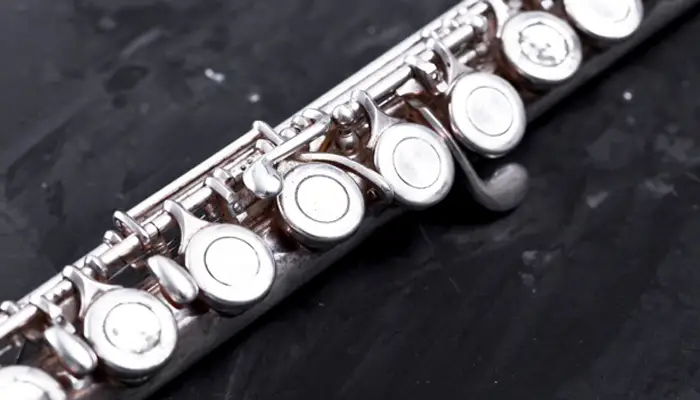
Are you curious about Why Is a Flute a Woodwind instrument?
Despite its seemingly different construction compared to other woodwinds, the flute indeed falls within this musical family.
In this guide, we will explore the intricate criteria that categorize the flute as a woodwind instrument, addressing common misconceptions and shedding light on its unique characteristics.
Understanding Why a Flute Is a Woodwind
The flute’s classification as a woodwind instrument stems from its method of sound production, which involves air vibrations. Unlike string instruments such as violins or cellos, which produce sound through vibrating strings, the flute relies on the flow of air.
When air is blown into the flute’s tube, it interacts with holes along the tube’s length, creating sound waves. These sound waves, though produced differently from those of traditional woodwind instruments, are nevertheless classified as such due to their nature as air vibrations.
Criteria for Classifying Woodwind Instruments
Let’s delve into the specific criteria used to classify woodwind instruments:
Criterion #1: Method of Sound Production
Instruments are typically categorized based on the mechanism by which they produce sound. While most instruments generate sound through the vibration of strings or membranes, the flute stands apart with its reliance on the flow of air.
By blowing air into the flute’s tube and manipulating the airflow through the openings along its length, sound waves are created. Though this method differs from the traditional techniques employed by other woodwind instruments, the fundamental principle of sound production through air vibrations remains intact.
This unique approach to sound generation not only distinguishes the flute but also underscores its versatility within the woodwind family.
Criterion #2: Use of Reeds
A defining characteristic of woodwind instruments is the use of reeds to produce sound. Traditionally, woodwinds utilize single or double reeds, which vibrate when air is blown across them, creating sound waves.
However, exceptions exist within this classification framework. The flute, for instance, does not rely on reeds for sound production. Instead, it utilizes the flow of air through strategically placed openings to generate melodic tones.
Despite this deviation from the norm, the flute’s classification as a woodwind instrument is justified by its adherence to the broader principles of sound production within the woodwind family.
This divergence highlights the rich diversity of woodwind instruments and challenges conventional categorizations, showcasing the flute’s unique contribution to the ensemble.
Criteria #3: Woodwind Instruments Have a Conical Bore
The shape of an instrument’s bore significantly influences its sound characteristics. Woodwind instruments typically feature conical bore shapes, which contribute to sound amplification and resonance.
However, the flute deviates from this norm with its cylindrical bore shape. While this distinction sets it apart from other woodwinds in terms of construction, it does not undermine its classification within the woodwind family.
Instead, it highlights the diversity of instruments encompassed by this classification, each with its unique sonic properties and playing techniques. The cylindrical bore of the flute facilitates a smooth and consistent airflow, resulting in its distinct timbre and tonal quality.
This variation in bore shape underscores the flute’s adaptability and versatility across musical genres and settings, solidifying its position as a cornerstone of the woodwind ensemble.
Criteria #4: The Way the Fingers Change the Pitch on a Woodwind Instrument
Pitch manipulation is a fundamental aspect of woodwind instrument performance. On instruments like the flute, pitch is altered by opening and closing strategically placed holes along the instrument’s length.
By controlling the airflow through these openings, musicians can produce a wide range of tones and melodies. This mechanism, achieved through precise finger placement and control, aligns with established woodwind classification criteria, further solidifying the flute’s position within this musical family.
The intricate fingerings and nuanced techniques required for pitch manipulation highlight the flute’s versatility and expressiveness, making it a vital component of orchestras, chamber ensembles, and solo performances alike.
For other instruments like the saxophone and transverse flute, fingers are raised and lowered inside the holes to achieve different pitches.
Frequently Ask Questions
Here we’re going to cover the FAQ of why is a flute a woodwind.
What distinguishes woodwind instruments from brass instruments?
Brass instruments, characterized by conical bores, trap air within their bodies, resulting in louder sound production. In contrast, woodwind instruments direct air away from their bodies, yielding quieter tones despite shared bore shapes.
What type of flute does opera singer Andrea Bocelli play?
Andrea Bocelli is known to play the Ceylonese flute, distinguished by its unique construction and tonal qualities.
How should one position their fingers while playing the flute?
Proper finger positioning is crucial for flute performance. The pinky finger is utilized for notes requiring a half step higher than the current note, such as C and D.
What is the name of the musical term for raising fingers inside holes to produce different pitches?
Trill, which is also used when referring to a bird’s singing.
You can also check out What’re the Different Types of Flutes of All the Time?
Conclusion – Why Is a Flute a Woodwind
Through an in-depth exploration of the flute’s unique characteristics and its alignment with established woodwind classification criteria, we have endeavored to provide clarity on why the flute is considered a woodwind instrument.
Should you have any further inquiries or comments, please feel free to share them in the comments section below.
You can also check out our guide on How to Play D Flat Major scale and An Exclusive Guide of Mixolydian Mode.


